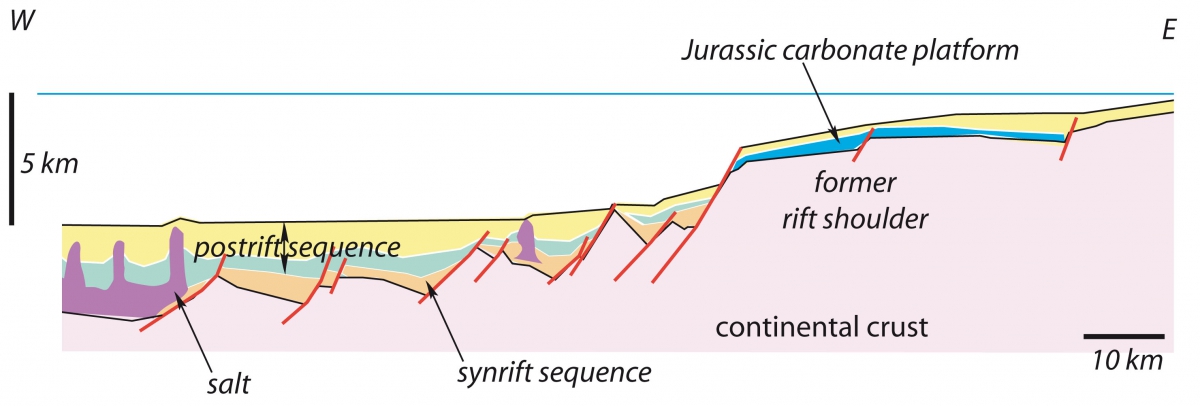Reconstructing past geography
The Atlantic margins are also used to build disappeared Alpine margins. During these plate reconstructions the importance of a third plate becomes apparent. The Iberian plate was composed of Spain, Portugal, the Balearic Islands, Sardinia, Corsica, and the Briançonnais alpine domain. The Valais Alps pertained largely to the Briançonnais domain located south of France. In Valais, this domain was separated from Europe by the Pyreneo-Valais Ocean, a narrow but deep inlet, which opened during the Cretaceous.
The reconstruction of the Alpine plate tectonic scenario is based on more than a century of geological research in the Alps and in surrounding regions.
At this time part of the Alpine Ocean, the Central Atlantic Ocean between north-western Africa and North-America is open and continues to widen. It's the Atlantic Ocean, which has provided information for the understanding of what happened in the Alps. In particular the reconstruction of successive mid-ocean ridge positions over the past 190 Ma have enabled precise positioning of the European and African plates over time.
The continental margins of the Central Atlantic Ocean and Morocco (modified from Favre & Stampfli 1992) can be used as a model to reconstruct the Alpine margins, being of a similar age and bordering the same ocean. When the Alpine margins were involved in the collision between Africa and Europe, sedimentation continued on the Moroccan margin during the Tertiary and Quaternary (yellow in the figure).

The film illustrates the reconstructed palaeography of the Alpine region: the plate movements that gave birth to the Alpine and Central Atlantic Oceans. The opening started 165 Ma ago and was followed 120 Ma ago by the fracture (rifting) of the northern margin producing the Pyreneo-Valais Ocean. Part of this detached northern margin became a peninsula between two oceans, called the Briançonnais domain, from which most of the Valais south of the Rhone is derived.
This new Cretaceous oceanic opening was also associated with the deposit of breccias mainly from the upper Jurassic. These have been deposited on a lower Jurassic series and can be observed at the Pierre Avoi in the Verbier region, in the Briançonnais in eastern Switzerland, and around the Galibier Pass region in France.
Sedimentation was limited on the isolated Briançonnais peninsula between this second rifting episode and the collision with the African plate. It consisted of “couches-rouges” – red-beds, pelagic red limestone, characteristic of marine deposits in deep water and common in the Prealps. Swept by ocean currents, creating gaps in the sedimentation, these 50 Ma long red-beds deposits are generally relatively thin, measuring only a few tens of metres. Metamorphic red-beds are visible in the Barrhorn series in Valais, in the Siviez-Mischabel Nappe.
NB: The movie illustrates that before the opening of the Alpine ocean during the Permian, the Alpine region was remote from any ocean. During the Triassic several large rifts developed producing small oceans, remnants of which exist in the Austrian Alps and in Greece. These rifts enabled the sea to return into the Alpine region from the Triassic onwards.
The Val d'Hérens is a testimony to rift formation during the Permian. Many rocks found between Evolène and Vex, quartzite or micaschists, have been transformed from thick detritic deposits composed of rocks such as sandstone and conglomerate deposited in these older rifts.
















